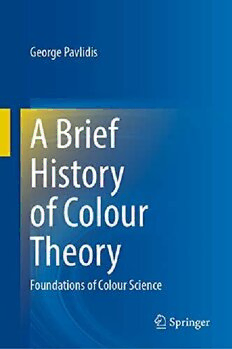
A Brief History of Colour Theory: Foundations of Colour Science PDF
Preview A Brief History of Colour Theory: Foundations of Colour Science
A Brief History of Colour Theory George Pavlidis A Brief History of Colour Theory Foundations of Colour Science GeorgePavlidis ILSP-InstituteforLanguageandSpeech Processing ATHENA-ResearchandInnovationCentre inInformation,Communication andKnowledgeTechnologies UniversityCampusatKimmeria Xanthi,Greece ISBN978-3-030-87770-5 ISBN978-3-030-87771-2 (eBook) https://doi.org/10.1007/978-3-030-87771-2 ©TheEditor(s)(ifapplicable)andTheAuthor(s),underexclusivelicensetoSpringerNature SingaporePteLtd.2021 Thisworkissubjecttocopyright.AllrightsaresolelyandexclusivelylicensedbythePublisher,whether thewholeorpartofthematerialisconcerned,specificallytherightsoftranslation,reprinting,reuse ofillustrations,recitation,broadcasting,reproductiononmicrofilmsorinanyotherphysicalway,and transmissionorinformationstorageandretrieval,electronicadaptation,computersoftware,orbysimilar ordissimilarmethodologynowknownorhereafterdeveloped. Theuseofgeneraldescriptivenames,registerednames,trademarks,servicemarks,etc.inthispublication doesnotimply,evenintheabsenceofaspecificstatement,thatsuchnamesareexemptfromtherelevant protectivelawsandregulationsandthereforefreeforgeneraluse. Thepublisher,theauthorsandtheeditorsaresafetoassumethattheadviceandinformationinthisbook arebelievedtobetrueandaccurateatthedateofpublication.Neitherthepublishernortheauthorsor theeditorsgiveawarranty,expressedorimplied,withrespecttothematerialcontainedhereinorforany errorsoromissionsthatmayhavebeenmade.Thepublisherremainsneutralwithregardtojurisdictional claimsinpublishedmapsandinstitutionalaffiliations. ThisSpringerimprintispublishedbytheregisteredcompanySpringerNatureSwitzerlandAG Theregisteredcompanyaddressis:Gewerbestrasse11,6330Cham,Switzerland Preface IamRikuSatoandIamrecordingthisincasethingsgosouth.TodayitisSunday,29th ofMarch,2314,acoldspringmorningwitharound5◦Celsiusoutside.Iammaking thesenotesathome,nearMaruyamaParkinSapporo,Hokkaido,northJapan.Iama BiotechnologyEngineerforBioSapCo.Ltd.,asmallcompanyjustoutsideSapporo, whichspecialisesinagricultureandfoodmanufacturing.Icanseefrommywindow the blooming of the cherry trees in Maruyama Park, a sight that has been known toattractattentionduetoitsexceptionallycolourfulbeautyforcenturies.Actually, thisisoneofthepartsofthemetropolisofHokkaidothatremainsthesamealong withsomeextrememountainousregionsontheisland.Theresthasbeenurbanised sincethemid-twenty-secondcenturywhenthemajorityofthe‘civilised’countries turnedtothehedonicsocietymodel afterintelligentrobotstookoveralmostallthe works in every sector. With most of the work being done by intelligent devices, peoplearenowexploringthelimitsofhedonisminwaysIshouldnotdiscussfurther here.Sincetheworldpopulationstabilisedtoaround9billioninthetwenty-second centuryduetovariousreasonsthatrelatetothequalityoflifedecisionsandnatural evolution factors, this is what happened to the whole world, actually. What is still changingthoughislifeexpectancy,whichbeforethenanotechnologyenhancements hadnaturallyreached100years,inJapan,110. Everyday life is interwoven with the Grid, the supercomputing network that connectseverythingontheentireplanet.Forhistoricalreasons,sufficetosaythat, asoftheearly2200s,nearlyacenturynow,personalsupercomputingdevicesarea commodity,enabledbyintelligence-guideddesignthatpushedelectronicsefficiency to the limits of current physics. I remember from my school years, people used to saythatMoore’sLawreacheditsphysicallimitatthatpointinhistory. About 10 years ago, nanotechnology has, for the first time, been successfully applied to upgrade human bodies, leading to what we now call the transhuman society. Even though not all people have accepted this change (yet), most have alreadytakenthisdirection,whichpracticallyleadstoimmortality,byenablingthe shiftingfromorganictodigitalandbodyswitching.Apartfromenhancingoursenses and abilities, this technology opened the way towards linking with each other and beingabletosharethoughtsandemotionsamongtheall-connectedrealandartificial v vi Preface consciousnesses on Earth. Speaking about myself, among various enhancements, I have already upgraded my visual sensation to be able to experience hyperspec- tral vision in microscopic and telescopic ranges and still strife to get used to the overwhelmingamountoftheinformationandthenewperceptionsitopened. For the record, to make the leap towards the new type of society we needed to make another leap. By the end of the twenty-third century, humanity matured to a stable Type 1 civilisation (remember Nicolai Kardashev’s scale?) and begun steps towardsType2,tocovertheallgrowingneedsforubiquitousenergy. OneofmyhobbiesthatIamdevelopingafterIembracedthenewhumancondition isthestudyofhistory.NowthatIgainedamuchdeeperinsightintobeing,allkinds ofhistoricaleventsseemtointriguememore.Like,forexample,when4yearsago the old Voyager I probe, which begun its space travel in 1977, finally reached the innerpartoftheOortCloud,theregionthatmarkstheendofthesolarsystem.This old craft is of historical interest, as it was the first to attempt such a long journey, although many more recent attempts have already surpassed it, thus rendering it a relic of the past space exploration. Apparently, the power systems of the probe havelongdiedoutanditwillfloatadrifttowardstheouterrimsofthesolarsystem forsomethousandsofyears.Nevertheless,eventslikethisseemtohaveadifferent meaning for me now, which I am able to experience within a broader perspective. Thisis,actually,alsothesourceofmyanxietyandfear,aslookingintothepasthas beenmarginalised,metwithextremescepticism,virtuallybanned,althoughnotby law, but by the societal customs since the beginning of the twenty-fourth century. Afterall,hedonicsocietiesrelyonnotlookingbackandthisiswhyIamafraidthis endeavourofminemightproverather‘unhealthy’. ItwasaweekagothatIwaslookingatthebloomingtreesinMaruyamaParkusing mynewlyenhancedhyperspectralvisionandwasabletoappreciateanewperception ofcolour;Iwasabletoselectivelyswitchbetweenvariousartificialfilters,implanted inmyneweyesandvisualprocessingpathways,toblockoutpartsofthelightreflected from the trees, or even create various colour composites that revealed interesting aspectsofthepropertiesofvegetation,likethehealthofthetreesortheirwatercontent andnitrogenconcentration.AsIfacilitatedmymicroscopicvisionabilitiesIwasable tozoomintothemolecularstructureoftheleavesandtheflowerstoexperiencethe real-time workings of plant life. Suddenly, I was overwhelmed with the query of howwasitevenpossibletothinkthatmypreviousstateofvisionwassufficientin thefirstplace.Thischainofthoughtledtoaneedforafurtherinvestigationofmy previousvisionmechanism,butalsoofthevariousvisualapparatusesthatwehave devised to mimic that primitive form of vision. I remembered an old technology, called photography, some people thought of it also as art. Today, with the four- dimensional holographic space-time projections, based on an extension of lattice quantumchromodynamics,thatoldtechnology,orart,orwhateveritmaybecalled seemslikeanotherrelicofthepast,whichisgood,right?Well,Ithought,whynot takeadeepbreathandsomeofmytimetolookintoit?Afterall,everyonehasaccess to everything through the Grid. Although I am not knowledgeable in the domains ofthephysicsoflight,optics,imagingchemistryandelectronics,aswellashuman visionbiology,myplanwastoaccesstheGridandgainasmuchinsightaspossible. Preface vii IhadtogodarkandapplyseverallayersofspoofingandmaskingtohidemyGrid identityforprotection,though,whichissomethingIcannotdiscussfurther. My initial search results were all too unclear, too messed up, too fragmented. I was able to locate excellent sources for the nature of light, for the physiology oftheeye,visionandvisualperception—whichissodifferentfromvision—forthe physicsoftheoptics,thephotochemistryandtherelatingreactions,thephotoelectric phenomenonandtheelectroniclightsensingandlightingtechnologies,thehistory anddevelopmentofphoto-sensingapparatuses.Alongthese,thereweresourcesfor the technical specifications of the human vision, which contradicted each other or agreedtoanaverage,atbest.Nosinglesourcewastobefoundtoprovidethefull insightintothenotionsinvolved.Allthesourcesagreed,though,thatanystudyof visionorvisualsensingdevicesstartswiththestudyoflight,movesonthedefini- tion of vision, the development of the notion of colour, and finally the analysis of the specifications of the various devices and some almost mystical principles, like that golden ratio rule; all these seemed like constant strife of human intelligence thoughttheages,datingbacktotheantiquity.Amongthestudies,thatofthehuman visualsensingmechanism,theeyehasaprominentposition.Thestudyofthevisual sensingapparatusesincludesinmostcasesthedisintegrationofcompositedevices intotheirmainparts,asthosepartshavebeendevelopedbasedontotallydifferent principles, although to the same end, to mimic the sensation of vision, but also to correctoralleviatesomelimitationsandnaturallyoccurringdefects.Inthemiddle of everything, I found the central notion of colour, its meaning, its scientific and semanticcontent.Colourbecamemyfocusofresearchandthusthefollowingtexts summarisethefindingsofthisinvestigation,hopefullyinaninsightfulwaysothatI mayhaveitasareferenceforthefuture,andmightbeofsomeutilitytootherson theGrid. AsIwasdiggingintotheGrid,Imanagedtogetmyhandsonanoldtwenty-first- centuryphotographyapparatusfrommygoodfriendIchikawhoisaConservatorin theSapporoArtMuseum,amongthelastsuchinstitutionstoholdfragmentsofthe humanmemory,unfortunatelywithlittlepublicinterestanymore.Thisapparatusis calledaphotographiccamera,whichwassupposedtobestateoftheartatthattime. I instantly developed an enthusiasm towards photography as a form of expression andalovefortheretro.Butwhatwouldphotographybeifitweren’tforcolourand vision? What is reported in the subsequent texts reflect my ongoing investigation for an in-depth understanding, experimentation and, sometimes, expression. It is my hope that this treatise will aid others in search of such understanding before everythingislostforever. Sapporo,Japan RikuSato March2314 Contents 1 Introduction ................................................... 1 2 ColourTheoryintheAncientTimes ............................. 5 2.1 Introduction .............................................. 5 2.2 AlcmaeonofCroton ....................................... 7 2.3 Parmenides ............................................... 8 2.4 Empedocles .............................................. 9 2.5 Protagoras ................................................ 10 2.6 Democritus ............................................... 11 2.7 Plato .................................................... 12 2.8 Aristotle ................................................. 14 3 ColourTheoryDuringtheMiddleAges .......................... 19 3.1 Alhazen .................................................. 19 3.2 Vitello ................................................... 21 4 TheModernEraofColourTheory ............................... 23 4.1 LeonardodaVinci ......................................... 23 4.2 JohannesKepler ........................................... 26 4.3 RenéDescartes ........................................... 32 4.4 IsaacNewton ............................................. 35 4.5 ChristiaanHuygens ........................................ 38 4.6 ImmanuelKant ........................................... 41 4.7 GeorgePalmer ............................................ 42 4.8 Goethe ................................................... 44 4.9 ThomasYoung ............................................ 45 4.10 Augustin-JeanFresnel ..................................... 50 4.11 ArthurSchopenhauer ...................................... 54 4.12 JohannesMüller ........................................... 58 4.13 WilliamHamilton ......................................... 64 4.14 HermannGünterGrassmann ................................ 66 4.15 HermannvonHelmholtz ................................... 69 ix x Contents 4.16 JamesClerkMaxwell ...................................... 77 4.17 EwaldHering ............................................. 80 4.18 GottlobFrege ............................................. 85 4.19 JohannesvonKries ........................................ 87 4.20 ArthurKönig ............................................. 92 4.21 RamónyCajal ............................................ 95 4.22 StephenPolyak ........................................... 98 4.23 ErwinSchrödinger ........................................ 102 4.24 LudwigWittgenstein ....................................... 107 4.25 GestaltPsychology ........................................ 109 4.26 JohnGuild ............................................... 111 5 Epilogue ....................................................... 127 References ........................................................ 133 List of Figures Fig.1.1 The timeline of the development of Optics according toThomasYoung(1807) ................................ 3 Fig.2.1 TheSchoolOfAthensbyRaffaelloSanzioDaUrbino ........ 7 Fig.2.2 JanSaenredam’sengravingofPlato’sAllegoryoftheCave .... 13 Fig.3.1 ThestructureofthehumaneyebyAlhazen ................. 20 Fig.3.2 CoverpagefromRisner’sOpticaethesaurus ................ 21 Fig.3.3 Vitello’sstereovisiondiagramfromRisner’sOpticae thesaurus ............................................. 22 Fig.4.1 Leonardo Da Vinci’s concept of double ray crossing intheeye ............................................. 25 Fig.4.2 AnatomicaldrawingsofthehumaneyefromKepler’s ParalipomenatoWiteloandtheOpticalPartofAstronomy, attributedtoFelixPlatter ................................ 30 Fig.4.3 Kepler’sdiagramthatdemonstratestheopticsofimage inversion .............................................. 31 Fig.4.4 Descartes’ graph of human visual perception fromTractacusdehomine(Descartes,1677) ................ 33 Fig.4.5 Descartes’graphofthehumaneyefromDehominefiguris (Descartes,1664) ...................................... 33 Fig.4.6 ReproductionofNewton’sfigureontherefractionthrough aprism(AX.VIII.intheOpticksstatesthattheobject D seenthroughaprismappearstobeinpositiond due torefraction) .......................................... 36 Fig.4.7 ReproductionofNewton’sdrawingforhisthirdexperiment onsupportofPropositionII,TheoremII(thatthesunlight consistsofdifferentlyrefrangiblerays) ..................... 37 Fig.4.8 ReproductionofNewton’scolourcircle;drawingadapted fromtheOpticks ....................................... 38 Fig.4.9 Huygens’depictionofthelightwavesfromacandleflame ..... 40 Fig.4.10 Huygens’depictionofthepropagationoflightwaves ......... 40 Fig.4.11 Huygens’depictionofreflection .......................... 41 xi
